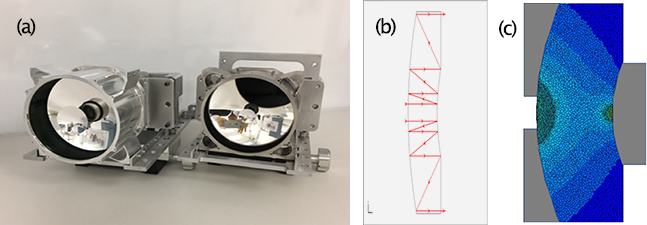Brian Bauman | 17-FS-030
Overview
We investigated the feasibility of applying our concept of compact, monolithic telescopes to create a compact, low-inertia laser beam projector capable of high slew rates suitable for directed energy (DE), laser communications, and power beaming applications. Traditional beam-director designs suffer from unwieldy size, high overall mass, and high moment of inertia, requiring large turrets with poor aerodynamic profiles and large power requirements. We conducted a preliminary engineering study to assess the feasibility of using monolithic telescopes for high-power beam directors. We developed a thermal model to find the temperature variation within the monolith (mostly due to coating absorption) and an optical model that quantified the optical impact of the heating. We also investigated heat mitigation methods to reduce optical impact and coating development to reduce the heat load from absorption (Beauville et al. 2004, Marchiò et al. 2018). We also developed plans and applications for the monolithic beam-director approach.
Background and Research Objectives
Beam control remains a vexing challenge in DE, laser communications, and power-beaming research and development. The beam director is the most massive component of the movable beam-control system. Current laser-beam directors must be engineered to suppress vibration. This results in an apparatus of unwieldy size, high mass, and high moment of inertia, which in turn requires a large turret with a poor aerodynamic profile and a large power demand. Compared to decades of breakthroughs in reducing laser source size, weight, and power, little technological progress has been made in the fundamental optical technologies of beam directors.
We applied our concept of monolithic telescopes to engineer a compact, low-inertia beam projector capable of high slew rates. Monolithic telescopes are formed from a single piece of glass, with reflective surfaces on opposite sides of the glass (see figure below). The solid internal structure prevents the optics from being misaligned. Monolithic optics can be designed to efficiently sink the heat generated from light absorbed in coatings and within the glass. Because of the monolith’s inherent rigidity and low moment of inertia, we also expected that it would be well-suited for several DE applications.
Photograph ( a ) of two imaging monolithic telescopes. Schematic diagram ( b ) of a monolithic telescope configured as a beam projector, the point design used for this study. Collimated laser light enters on the left side and exits on the right side after four reflections ( red arrows ) within the monolith. Cross-section ( c ) of a thermal model showing finite-volume cells. Colors indicate temperature. Gray areas represent aluminum heat sinks on the back side of each reflective surface.
We built 15 monolithic telescopes with 8.5- to 17-cm diameters for imaging applications. We initiated this feasibility study because we did not know whether the monolithic optic could be applied to beam directors. Specifically, we did not know if the laser power absorbed by the telescope would cause unacceptable aberrations and, if so, whether we could engineer heat mitigation that would bring aberrations into an acceptable range. Those results in turn informed us as to the possible application spaces.
We (1) assessed the application space for the best fit of the monolithic approach; (2) created a thermal model to calculate the effects of bulk and coating absorption and the effects of active cooling strategies; (3) evaluated possible approaches and development paths for lower-absorption coatings; (4) developed an optical model to relate the heating calculated by the thermal model to the actual optical performance using appropriate figures of merit; and (5) created compelling point designs and development plans for the most promising applications of monolithic approaches.
Impact on Mission
Developing DE applications has been a significant activity for Lawrence Livermore National Laboratory. Laser propagation from compact, stable platforms is important for a range of applications in astronomy, remote sensing, communications, and national security (Ellis 2015). By contributing to the Laboratory’s efforts to field fully engineered laser-propagation systems for the Department of Defense, our research supports the NNSA goal to expand and apply our science and technology capabilities to deal with a range of national security challenges. Furthermore, through the development of more robust DE systems, this study supports the Laboratory’s research and development challenges in directed energy and space security. It also enhances the Laboratory's core competency in lasers and optical science and technology.
Conclusion
If modest power (10 to 60 kW), short-duration DE applications become a strategic interest at the Laboratory, or if future DE applications include refocusing and/or adaptive optics, we believe that the Laboratory should initiate further research on this topic. The next step should be to conduct a small-scale laboratory test of a monolithic beam director. An existing monolith could be adapted for a test with significant laser power. An engineering study could be conducted, as necessary, to develop a monolith with an aperture of approximately 8.5 cm that could be used specifically in a field test, ideally at a facility with down-range directed-energy instrumentation. The aim of the demonstration would be to generate interest and funding from government sponsors.
References
Beauville, F., et al. 2004. "The VIRGO Large Mirrors: A Challenge for Low Loss Coatings." Classical and Quantum Gravity 5(21): S935–S945. doi: 10.1088/0264-9381/21/5/083.
Ellis, J. D., 2015. "Directed-Energy Weapons: Promise and Prospects." 20 YY Series, Center for a New American Security. Accessed 14 January 2019. https://s3.amazonaws.com/files.cnas.org/documents/CNAS_Directed_Energy_….
Marchiò, M., et al. 2018. "Optical Performance of Large-Area Crystalline Coatings." Optics Express 26(5): 6114–6125. doi: 10.1364/OE.26.006114.






